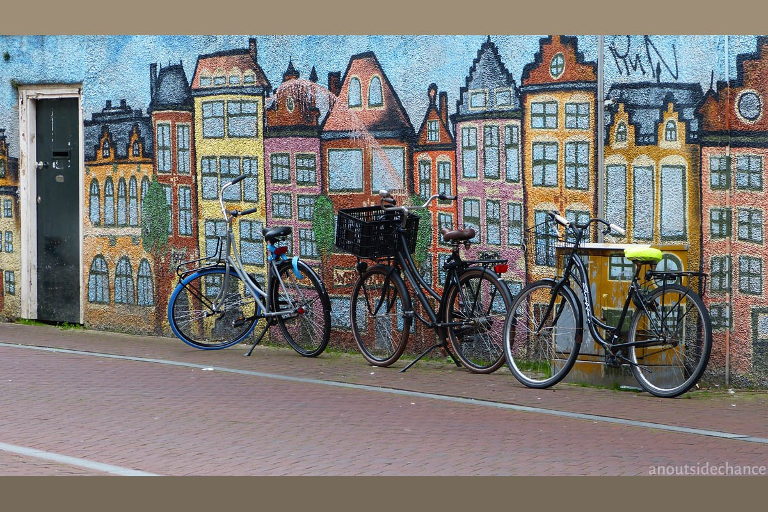How would you describe the process in which a small country builds a 35,000 kilometer network of fully separated bike infrastructure – and traffic-calms 75 per cent of their urban streets to a speeds of 30 km/h (19 mph) or less?
Building the Cycling City, published by Island Press, August 2018
One apt analogy is “picking the low-hanging fruit”. While Dutch cycling policy has required only modest annual investment, it has resulted in cities where bikes are used for most short trips – five kilometers or less – which can be pedaled by ordinary citizens from age 8 to 80 with no great effort. Furthermore this policy has helped preserve historic urban centers by removing the need for intra-city expressways or vast parking lots, while also promoting a fit and healthy population.
These are some of the themes that come through in a recent book by Melissa and Chris Bruntlett. Building The Cycling City: The Dutch Blueprint for Urban Vitality provides an excellent overview of the different ways that transportation policy has developed in five Dutch cities. The book also shows how lessons learned there are now benefitting other cities including New York, Calgary, Vancouver, and San Antonio.
This article is based on the Bruntletts’ excellent work, as well as on my own four-week bike tour of the Netherlands in September and October.
Giving priority to the most vulnerable road users, not the least vulnerable
In cities throughout the industrial world in the 20th century, the lion’s share of public space became the domain of people engaged in a dangerous and polluting activity – driving cars. The Netherlands was no exception to this trend.
But by the mid-1970s, spurred in part by a growing number of traffic fatalities and in part by the OPEC oil embargo, a strong reaction to auto-dominance took hold in several Dutch cities.
In the northern city of Groningen, a plan to build big new roads through historic neighbourhoods prompted 24-year-old Max Van den Berg to get into municipal politics. Just seven years later, the city implemented a transportation policy promoted by Van den Berg and allied councillors. Their Traffic Circulation Plan
“proposed dividing the city center to four parts and forbidding cars to cross between those quarters. This made the inner city practically impenetrable with a car, leaving cycling and walking the best ways to get around. The plan didn’t completely remove motor vehicles from the equation – as public buses and delivery vans would retain limited access to parts of the core – but it came remarkably close.” (Building the Cycling City, page 53-54)
One result 40 years later is that distracted walking or cycling is not a capital crime in Dutch cities. Even at rush hour in Groningen, one can walk or pedal through the central city while engrossed in conversation, while focusing on a smart phone, or while writing the next great novel in your head – without fear of being squashed by a car.
The same pattern holds true in many other small- and mid-sized Dutch cities where the urban core is mostly free of the noise, pollution and danger posed by cars. While some cars and delivery vehicles creep through these districts, the drivers know that foot-powered residents have the right of way – not just at crosswalks or traffic lights but all along the length of narrow historic streets.
Above, a “scramble” in Groningen at rush hour, where cyclists going every direction smoothly negotiate their way through the intersection. Below, an intersection in the core of Leeuwarden, the capital city of the province of Friesland.
Today, Groningen’s traffic planning embodies a very basic principle: “pedestrians over cyclists, cyclists over public transportation, and public transportation over cars. Essentially, the most vulnerable users of the city have priority over the least ….” (Building the Cycling City, page 61)
The important but limited role of separated bike lanes
The Netherlands is justly famous for its vast network of protected bike lanes, not only along arterial roads within cities, but also throughout the countryside connecting every village, town and city.
The rules for when, where and how cycle lanes are built are now well defined. Basically, in areas where it is not practical to slow cars so that they travel at close to the speeds of bicycles, separated paths must be installed. In cities, this often means a street-side lane with a curb separating the bike traffic from car traffic. In most cases these cycle lanes run on both sides of the streets. Critically, the urban bike lanes are not carved out of the sidewalks – the realm of pedestrians, who are also to be protected and encouraged – but are achieved by narrowing or removing car lanes.

“Bicycle street. Autos are guests.”
On rural roads with moderately fast cars but low traffic volumes, separate bike lanes are not always installed but cars are expected to – and do, in my experience – pass bikes carefully and courteously, yielding to bikes whenever oncoming traffic makes it impossible to pass safely.
Alongside busier roads with traffic of 50–60 km/hr or faster, there are fully separated bike lanes. Often these run right beside the roads, but there are also many cases where the bike paths diverge from the roads significantly, providing a quieter ride and cleaner air for people on bikes.
A significant component of the system is the system of signage. Bicycle routes are marked by signs at nearly every intersection, with signs that are visually distinct from the directional signs for motorists. This makes it easy for a bike rider to navigate through new areas, without pulling out either a smart phone or a paper map. There are also hundreds of maps on metal signposts showing local cycling routes, with each province maintaining its own set of local route maps.
Above, a roadside sign showing local cycling routes in the northern province of Friesland. Below, a popular cycling route on the coast in the southern province of Zeeland.
All this infrastructure, of course, costs money – but is it expensive? That’s a matter of perspective, and the Dutch do spend more money on cycling infrastructure than other nations. Melissa and Chris Bruntlett write,
“The Dutch cycle because their government spends an astonishing €30 ($35 US) per person per year on bike infrastructure – fifteen times the amount invested in nearby England.” (Building The Cycling City, page 15)
Yet this €30 per person is a very small fraction of what the Dutch – and other nations – spend on auto infrastructure. According to official figures from 2015, “The Dutch government spends a total of 15 billion euros on traffic and transport” each year – meaning the cycling infrastructure expense is a bit more than 3% of the government transport and traffic budget.
For this €30 per capita, the Dutch have been able to preserve the character of their central cities, keep carbon emissions lower than in neighboring countries, and enjoy some of the best health in the world due to an active population and cleaner air. Given the cost of health care alone, the €30 per capita spent by the Dutch government to promote cycling is an astonishing bargain.
While infrastructure such as separated cycle paths is an important component of the cycle strategy, it is important to keep in mind that the Dutch did not immediately launch a major building program when they began to focus on cycling in the 1970s. Furthermore, even today about 75 percent of their roads do not have separate cycle lanes.
In their chapter on Amsterdam, Melissa and Chris Bruntlett explain,
“This cycling utopia was built on traffic-calming rather than bike lanes. Instead of constructing separated cycle tracks on every street, officials started with speed-limit reductions, parking restrictions, through-traffic limitations, and lane narrowing and removals.” (Building the Cycling City, page 93)
Cycle lanes are great, but you’ve got to get from home or office or school to the cycle lane, and that route must be safe before most urban residents will want to bike on a regular basis. If the route to and from a dedicated cycle path remains dangerous and nerve-wracking, only the daring folks who are already cycling are likely to get onto the cycle path.
Traffic-calming on most or all non-arterial roads, therefore, plays a crucial role in laying the groundwork for widespread use of separated bike lanes along major routes. Fortuitously, the cost of traffic-calming methods is generally very low, meaning that is an obvious place to start in a long-term strategy to boost active transportation.
In the next installment, I will look at ways the Dutch are extending the humble bicycle’s reach through an intentional symbiosis with their train network, and through the rapid uptake of electric-assist bikes. A third installment in this series will look at cycling promotion efforts in Valencia, Paris and London, in light of the Dutch example.

In the historic centre of Middelburg, province of Zeeland.
Top photo: mural and bikes in downtown Leeuwarden, Friesland











